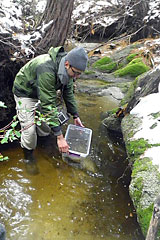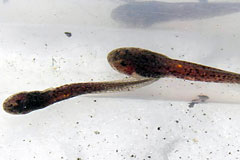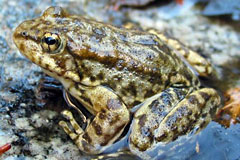Reserves give species new lease on life

With splashes and plops, the tadpoles slipped from their clear plastic bags into the stream. No glasses of champagne were raised to celebrate the moment. But just like that, biologists reintroduced one of the world's most endangered amphibians back into the wild.
Only about 200 southern mountain yellow-legged frogs remain in California streams. Now 36 more are being looked after at a University of California natural reserve.
The release represents rare good news for California's beleaguered amphibians. The southern mountain yellow-legged frog (Rana muscosa) is one of four Southern California frogs and toads on the federal endangered species list. The species has disappeared from more than 99 percent of its historic range over the past 30 years — one of many examples of declining biodiversity. Worldwide, amphibians have suffered drastic population declines due to climate change, pesticide use, a pathogen called the chytrid fungus and invasive species.
The captive-bred tadpoles were set free in natural pools at the James San Jacinto Mountains Reserve. The Southern California site is part of the UC Natural Reserve System and administered by UC Riverside.
The reserve was a natural choice for the release. "Being a UC reserve, it's very well secured," said ecologist Adam Backlin of the U.S. Geological Survey. "We can use equipment such as water-quality meters, cameras and cages for releasing tadpoles there and don't have to worry about people tampering with it."
The reserve affords protection for the frogs as well.
"This is a large frog for Southern California," Backlin said "People doing recreation see them and pick them up; kids like to take them home or play with them. We don't have to worry about those problems here."
The James San Jacinto Mountains Reserve is proven habitat for the southern mountain yellow-legged frog. A naturally occurring population lived in the release stream as recently as the mid-1990s. "One of the things we don't have a handle on is their habitat requirements," Backlin said. "We figure there's something in that habitat they like to have made it this far."

The frog reintroduction is one of many ways that the UC Natural Reserve System supports global biodiversity. For example, the beaches at Coal Oil Point Reserve, administered by UC Santa Barbara, are protected from human visitors to encourage breeding colonies of the federally threatened western snowy plover.
Research at Hastings Natural History Reservation, administered by UC Berkeley, has demonstrated that gophers, which have proliferated in nonnative annual grasslands, are a major culprit in decimating oak seedlings.
The Partnership for Interdisciplinary Studies of Coastal Oceans surveys of intertidal and marine organisms provide information required to monitor the health of near-shore ecosystems. These survey sites include the Big Creek, Bodega Marine and Scripps Coastal reserves, administered by UC Santa Cruz, UC Davis, and UC San Diego, respectively. And every one of the system's 36 reserves protects increasingly scarce natural habitat for a wide variety of native species.
The frog reintroduction began in April 2010, when about 500 eggs were brought to the reserve. In August, tadpoles were placed in aquatic cages at the same stream. Half were released into stream pools two weeks later. The remaining 18 were fed and monitored in the cage for three more months. This second group was set free after the first snowfall, on Nov. 23, to overwinter in the wild. The tadpoles now are between 1 and 2½ inches long. By next spring, they will resemble frogs with tails but will not complete their metamorphosis into adult frogs until the following winter. Scientists will recapture the young frogs in late April to monitor their development. The animals are not expected to stray far from their release pools.
All of the tadpoles are marked with a plastic tag and a colored dot beneath the skin of the back of the neck. The markers identify the rearing and release conditions for each tadpole. The information from recaptured frogs will help refine future reintroductions for the species. The researchers plan to conduct additional releases at the reserve next year.

The tadpole release and other efforts to promote biodiversity helped to single out the UC reserve system for special international recognition this year by the International Union for Conservation of Nature. Nearly 1,100 organizations from more than 60 countries joined the union's Countdown 2010 initiative. The UC reserve system was one of the 20 best biodiversity success stories highlighted in the Made in Countdown 2010 publication and the only group in North America to receive this distinction.
The United Nations declared 2010 the International Year of Biodiversity to encourage efforts to support biodiversity around the world. The Natural Reserve System petitioned to become a Countdown 2010 signatory in February. The petition pledged to fight the causes of declining biodiversity in specific ways, including supporting education about ecosystem biodiversity and developing new systemwide initiatives such as a seed bank for native California flora.
"It's an honor to be chosen as one of the top 20 global success stories," says NRS Director Peggy L. Fiedler. "The project to breed the southern mountain yellow-legged frog in captivity and translocate the eggs to the James San Jacinto Mountains Reserve was a true collaboration. We worked closely with both public and private organizations, including the U.S. Fish & Wildlife Service, USDA Forest Service, California Department of Fish and Game, and the Zoological Society of San Diego. Our success is a testament to the expertise and dedication of all parties."
The Made in Countdown 2010 chapter about the NRS describes the refuge provided by reserve sites to endangered and threatened species, and recognizes the system's role in supporting research, stewardship, and education projects focused on biodiversity. In addition to the frog release, the article cites the identification of a new insect species at the Sedgwick Reserve, administered by UC Santa Barbara, and the first California sighting of a wolverine in 86 years at Sagehen Creek Field Station, administered by UC Berkeley. The article also recognized the education programs based at UC reserves, such as Adventure Risk Challenge, which combines outdoor education and science classes with intensive English-language instruction, and Exploring California Biodiversity, which takes urban elementary school students to field stations to experience the natural environment. These and other field classes at reserve sites bring the concept of biodiversity to life for thousands of youngsters and college students every year.
The University of California Natural Reserve System has been a haven for the state's diverse ecosystems and species since 1965. The 36 reserves in the UC system encompass more than 135,000 acres and include habitats ranging from tidepools and oak savannahs to redwood forests, deserts and alpine tundra. The reserve system supports university-level teaching, research and public service for thousands of users each year. Find the NRS on Facebook.
More Information:
NRS in Made in Countdown 2010
James San Jacinto Mountains Reserve
Videos about the captive breeding program for the frogs and the tadpole release, including an interview with Becca Fenwick, the NRS's James San Jacinto Mountains Reserve director
